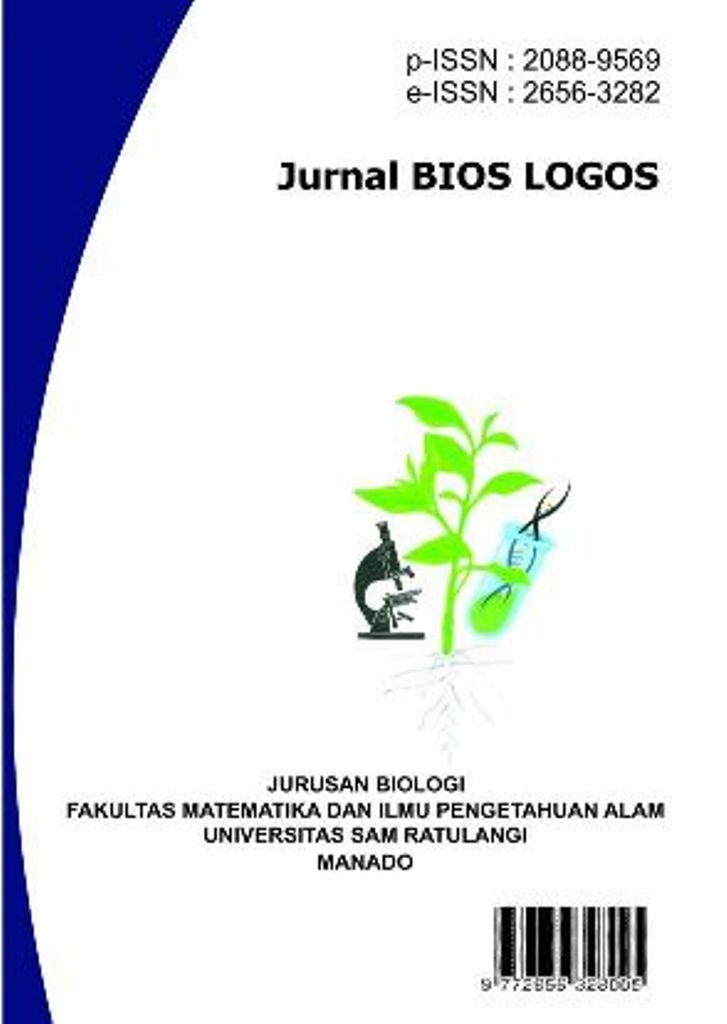In Vitro Evaluation of the Antagonism of Saprophyte and Endophytic Fungi Isolated from Groundnut (Arachis hypogaea) Against Soil-Transmitted Diseases Sclerotium rolfsii
DOI:
https://doi.org/10.35799/jbl.v13i1.46484Keywords:
antagonism, saprophytic fungi, endophytic fungi, soil-borne fungi, population level, ground peanutAbstract
Certain soil-borne diseases can have a detrimental effect on the quality and quantity of peanut production. One of the soil-borne diseases is Sclerotium rolfsii, a fungus that is the primary limiting factor in peanut plants. An alternative to controlling this fungus is to use saprophytic and endophytic fungi. The purpose of this study was to evaluate several saprophytic and endophytic fungi isolated from peanut plants in vitro as antagonistic agents against S. rolfsii. Isolation of saprophytic and endophytic fungi was carried out using the stratified dilution method. The fungal antagonism test was carried out using a non-factorial completely randomized design with 3 replications. The parameters observed in this study included the inhibiting zone, the diameter of the isolate colonies, the growth area, and the interaction of saprophytic and endophytic fungi with S. rolfsii. Five families and eight species of soil fungi were identified using macroscopic and microscopic identification techniques. The type of soil fungus has a large impact on the growth rate and inhibition area. Mucor hiemalis grew at the fastest rate, while Rhizopus oryzae had the largest inhibition zone.
References
Carr, S., Francis, M., Rivlin, L. G., & Stone, A. M. (1992). Public space. Cambridge University Press.
Agrios, G.N. (2005). Plant Pathology. Edisi 5. Elsevier Academic Press, USA. 922p.
Aryantha, I.N.P. (2001). Membangun Sistem Pertanian Berkelanjutan. KPP Ilmu Hayati LPPM-ITB, Dept. Biologi - FMIPA-ITB. Ganesha, Bandung.
Dharmaputra, O.S., Gunawan, A.W., Wulandari, R., dan Basuki, T. (1999). Cendawan kontaminan dominan pada bedengan jamur merang dan interaksinya dengan jamur merang secara in vitro. J. Mikro. Indonesia, 4(1):14-18.
Fachruddin, L. (2000). Budidaya Kacang-Kacangan. Kanisius. Cetakan Ke-6. Yogyakarta.
Farida, S. (1992). Penggunaan Jamur Saprob Tanah Untuk Mengendalikan Fusarium oxysporum Pada Tanaman Tomat (Lycopersicum esculenta). J. IPM. 2(1):24-29.
Freeman, S., Zveibel, A., Vintal, H., and Maymon, M. (2002). Isolation of Nonpatogenic Mutants of Fusarium oxysporum f.sp. Melonis For Biological Control of Fusarium Wilts In Cucurbits. Phytopathology, 92:164-168.
Gandjar, I., R.A. Samson, K. van den Tweel-Vermeulen, A. Oetari and I. Santoso. (1999). Pengenalan Kapang Tropik Umum. Jakarta: Yayasan Obor Indonesia.
Ilyas, M. (2006). Isolation and Identification of Molds on Plant Rizosung in Gunung Mutis Nature Reserve, East Nusa Tenggara. Biodiversity, 7(3): 216-220.
Indrawati, I., dan Sarah, D. F. (2016). Isolasi Dan Identifikasi Jamur Patogen Pada Air Sumur Dan Air Sungai Di Pemukiman Warga Desa Karangwangi, Cianjur, Jawa Barat. Jurnal Biodjati, 1(1): 27-38.
Magenda, S., Febby, E.F.K., dan Stella, D.U. (2011). Karakteristik Isolat Jamur Sclerotium rolfsii dari Tanaman Kacang Tanah (Arachis hypogaea Linn.). Jurnal Bios Logos, 1(1):1-7.
Mehan, V.K., Y. J. Tan, and B.S. Liao. (1995). Inoculation Techniques to Evaluate Resistance of Groundnut to Bacterial Wilt. pp. 59–62 In V.K. Mehan and D. McDonald (eds.). Techniques For Diagnosis of P. solanacearum and for Resistance Screening Against Groundnut Bacterial Wilt. ICRISAT Technical Manual no.1.
Nautiyal, P.C. (2002). Groundnuts: Post-harvest Operations. Research Centre for Groundnuts (ICAR). [www.icar.org.in] diakses 23 Mei 2013.
Porter, M.D., Smith, H.D. and Kabana, R.R. (1984). Compendium of Peanut Diseases. The American Phytipathological Society. United States of America. 73 hal.
Rahayu, B. (2003). Uji Ketahanan Varietas Kacang Tanah Terhadap Penyakit Sclerotium rolfsii Sacc. di Lahan Petani (On Farm Research). [Skripsi]. Fakultas Pertanian. Institut Pertanian Bogor. Bogor. 59 hal.
Samson, R.A., E.S. Hoekstra and C.A.N. Van Oorschot. (1995). Introduction To Food-Borne Fungi. Institute of The Royal Netherlands Academic of Arts and Sciences.
Sinaga, M.H. (2009). Pengaruh Bio Va-Mikorizadan Pemberian Arang terhadap Jamur Fusarium oxysporum f.sp. capsici pada Tanaman Cabai (Capsicum annuum) di Lapangan. Skripsi.Universitas Sumatera Utara, Medan.
Soesanto, L. (2008). Pengantar Pengendalian Hayati Penyakit Tanaman. Rajawali press. Jakarta.
Soesanto, L. (2013). Pengantar Pengendalian Hayati Penyakit Tanaman. Edisi kedua. Rajawali Pers. Jakarta.
Subowo. (2012). Pemberdayaan sumber daya hayati tanah untuk rehabilitasi tanah Ultisol terdegradasi. Jurnal Sumberdaya Lahan, 6(2): 79-88.
Sudarma, I.M., dan Suprapta, D.N. (2011). Potensi Jamur Antagonis yang Berasal dariHabitat Tanaman Pisang dengan dantanpa Gejala Layu Fusarium untuk Mengendalikan Fusarium oxysporum f.sp. cubense Secara In Vitro. Skripsi. Fakultas Pertanian Universitas Udayana. Bali.
Suhartina, Febby E.F. Kandou, Marina F.O. Singkoh. (2018). Isolasi dan Identifikasi Jamur Endofit Pada Tumbuhan Paku Asplenium nidus. Jurnal MIPA. https://ejournal.unsrat.ac.id/index.php/jmuo/article/view/20640 (Diakses pada tanggal 25 Oktober 2021).
Sunarwati, D., dan Yoza, R. (2010). Kemampuan Trichoderma sp. dan Penicilium sp. dalam Menghambat Pertumbuhan Cendawan Penyebab Penyakit Busuk Akar Durian (Phytophtora palmivora) Secara in-Vitro. Seminar Nasional Program & Strategi Pengembangan Buah Nusantara. Solok 10 Desember 2010.
Sumarsih, S. (2003). Mikrobiologi Dasar. Fakultas Pertanian UNP Veteran. Yogyakarta.
Triharso. (1996). Dasar-dasar Perlindungan Tanaman. UGM Press, Yogyakarta.
Umboh, S.D. (2016). Analisis Kadar Residu Pestisida dan Bioakumulasinya Terhadap Laba-Laba Predator, Fisikokimia, dan Biologi Tanah Di Pertanaman Sayuran Kubis. Disertasi. Universitas Sam Ratulangi. Pascasarjana. Manado.
Yulianto, E. (2014). Evaluasi Potensi Beberapa Jamur Agen Antagonis Dalam Menghambat Patogen Fusarium sp. Pada Tanaman Jagung (Zea mays l.) Skripsi. Program Studi Agroekoteknologi, Jurusan Budidaya Pertanian, Fakultas Pertanian, Universitas Bengkulu.
Downloads
Published
How to Cite
Issue
Section
License
Copyright (c) 2022 Johanis Pelealu, Edwin de Queljoe, Lalu Wahyudi, Stella Deiby Umboh, Trina Tallei

This work is licensed under a Creative Commons Attribution-ShareAlike 4.0 International License.




